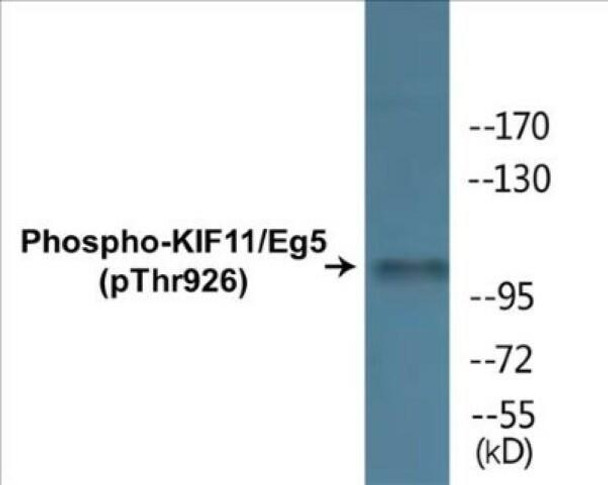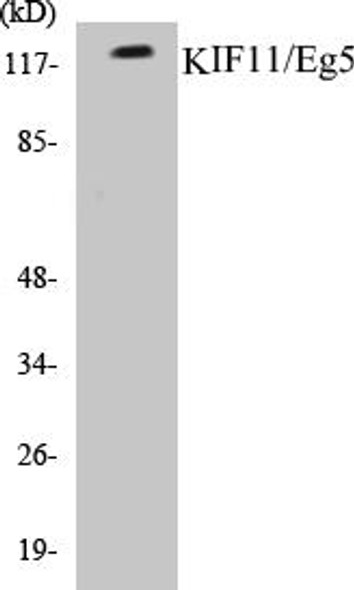Description
| Product Name: | KIF11/Eg5 (Phospho-Thr926) Colorimetric Cell-Based ELISA |
| Product Code: | CBCAB01460 |
| ELISA Type: | Cell-Based |
| Target: | KIF11/Eg5 (Phospho-Thr926) |
| Reactivity: | Human |
| Dynamic Range: | > 5000 Cells |
| Detection Method: | Colorimetric 450 nm |
| Format: | 2 x 96-Well Microplates |
The KIF11/Eg5 (Phospho-Thr926) Colorimetric Cell-Based ELISA Kit is a convenient, lysate-free, high throughput and sensitive assay kit that can detect KIF11/Eg5 protein phosphorylation and expression profile in cells. The kit can be used for measuring the relative amounts of phosphorylated KIF11/Eg5 in cultured cells as well as screening for the effects that various treatments, inhibitors (ie. siRNA or chemicals), or activators have on KIF11/Eg5 phosphorylation.
Qualitative determination of KIF11/Eg5 (Phospho-Thr926) concentration is achieved by an indirect ELISA format. In essence, KIF11/Eg5 (Phospho-Thr926) is captured by KIF11/Eg5 (Phospho-Thr926)-specific primary (1ø) antibodies while the HRP-conjugated secondary (2ø) antibodies bind the Fc region of the 1ø antibody. Through this binding, the HRP enzyme conjugated to the 2ø antibody can catalyze a colorimetric reaction upon substrate addition. Due to the qualitative nature of the Cell-Based ELISA, multiple normalization methods are needed:
| 1. | A monoclonal antibody specific for human GAPDH is included to serve as an internal positive control in normalizing the target absorbance values. |
| 2. | Following the colorimetric measurement of HRP activity via substrate addition, the Crystal Violet whole-cell staining method may be used to determine cell density. After staining, the results can be analysed by normalizing the absorbance values to cell amounts, by which the plating difference can be adjusted. |
| Database Information: | Gene ID: 3832, UniProt ID: P52732, OMIM: 148760, Unigene: Hs.8878 |
| Gene Symbol: | KIF11 |
| Sub Type: | Phospho |
| UniProt Protein Function: | KIF11: a cytoskeletal protein that belongs to the kinesin-like protein family. BimC subfamily. Interacts with the thyroid hormone receptor in the presence of thyroid hormone. Plays a role in chromosome positioning, centrosome separation and establishing a bipolar spindle during cell mitosis. Phosphorylation regulates its association with the spindle apparatus. |
| UniProt Protein Details: | Protein type:Motor; Microtubule-binding Chromosomal Location of Human Ortholog: 10q24.1 Cellular Component: spindle pole; kinesin complex; microtubule; membrane; spindle microtubule; cytoplasm; spindle; cytosol Molecular Function:plus-end-directed microtubule motor activity; microtubule binding; ATPase activity; protein complex binding; microtubule motor activity; protein kinase binding; ATP binding Biological Process: mitosis; mitotic centrosome separation; mitotic spindle organization and biogenesis; cell division; metabolic process; regulation of mitotic centrosome separation; antigen processing and presentation of exogenous peptide antigen via MHC class II; blood coagulation; spindle organization and biogenesis; microtubule-based movement; chromosome segregation Disease: Microcephaly With Or Without Chorioretinopathy, Lymphedema, Or Mental Retardation |
| NCBI Summary: | This gene encodes a motor protein that belongs to the kinesin-like protein family. Members of this protein family are known to be involved in various kinds of spindle dynamics. The function of this gene product includes chromosome positioning, centrosome separation and establishing a bipolar spindle during cell mitosis. [provided by RefSeq, Jul 2008] |
| UniProt Code: | P52732 |
| NCBI GenInfo Identifier: | 116242604 |
| NCBI Gene ID: | 3832 |
| NCBI Accession: | P52732.2 |
| UniProt Secondary Accession: | P52732,Q15716, Q5VWX0, A0AV49, B2RMV3, |
| UniProt Related Accession: | P52732 |
| Molecular Weight: | 119,159 Da |
| NCBI Full Name: | Kinesin-like protein KIF11 |
| NCBI Synonym Full Names: | kinesin family member 11 |
| NCBI Official Symbol: | KIF11 |
| NCBI Official Synonym Symbols: | EG5; HKSP; KNSL1; MCLMR; TRIP5 |
| NCBI Protein Information: | kinesin-like protein KIF11; TR-interacting protein 5; TRIP-5; kinesin-like protein 1; kinesin-like spindle protein HKSP; kinesin-related motor protein Eg5; thyroid receptor-interacting protein 5 |
| UniProt Protein Name: | Kinesin-like protein KIF11 |
| UniProt Synonym Protein Names: | Kinesin-like protein 1; Kinesin-like spindle protein HKSP; Kinesin-related motor protein Eg5; Thyroid receptor-interacting protein 5; TR-interacting protein 5; TRIP-5 |
| Protein Family: | Kinesin-like protein |
| UniProt Gene Name: | KIF11 |
| UniProt Entry Name: | KIF11_HUMAN |
| Component | Quantity |
| 96-Well Cell Culture Clear-Bottom Microplate | 2 plates |
| 10X TBS | 24 mL |
| Quenching Buffer | 24 mL |
| Blocking Buffer | 50 mL |
| 15X Wash Buffer | 50 mL |
| Primary Antibody Diluent | 12 mL |
| 100x Anti-Phospho Target Antibody | 60 µL |
| 100x Anti-Target Antibody | 60 µL |
| Anti-GAPDH Antibody | 60 µL |
| HRP-Conjugated Anti-Rabbit IgG Antibody | 12 mL |
| HRP-Conjugated Anti-Mouse IgG Antibody | 12 mL |
| SDS Solution | 12 mL |
| Stop Solution | 24 mL |
| Ready-to-Use Substrate | 12 mL |
| Crystal Violet Solution | 12 mL |
| Adhesive Plate Seals | 2 seals |
The following materials and/or equipment are NOT provided in this kit but are necessary to successfully conduct the experiment:
- Microplate reader able to measure absorbance at 450 nm and/or 595 nm for Crystal Violet Cell Staining (Optional)
- Micropipettes with capability of measuring volumes ranging from 1 µL to 1 ml
- 37% formaldehyde (Sigma Cat# F-8775) or formaldehyde from other sources
- Squirt bottle, manifold dispenser, multichannel pipette reservoir or automated microplate washer
- Graph paper or computer software capable of generating or displaying logarithmic functions
- Absorbent papers or vacuum aspirator
- Test tubes or microfuge tubes capable of storing ≥1 ml
- Poly-L-Lysine (Sigma Cat# P4832 for suspension cells)
- Orbital shaker (optional)
- Deionized or sterile water
*Note: Protocols are specific to each batch/lot. For the correct instructions please follow the protocol included in your kit.
| Step | Procedure |
| 1. | Seed 200 µL of 20,000 adherent cells in culture medium in each well of a 96-well plate. The plates included in the kit are sterile and treated for cell culture. For suspension cells and loosely attached cells, coat the plates with 100 µL of 10 µg/ml Poly-L-Lysine (not included) to each well of a 96-well plate for 30 minutes at 37 °C prior to adding cells. |
| 2. | Incubate the cells for overnight at 37 °C, 5% CO2. |
| 3. | Treat the cells as desired. |
| 4. | Remove the cell culture medium and rinse with 200 µL of 1x TBS, twice. |
| 5. | Fix the cells by incubating with 100 µL of Fixing Solution for 20 minutes at room temperature. The 4% formaldehyde is used for adherent cells and 8% formaldehyde is used for suspension cells and loosely attached cells. |
| 6. | Remove the Fixing Solution and wash the plate 3 times with 200 µL 1x Wash Buffer for five minutes each time with gentle shaking on the orbital shaker. The plate can be stored at 4 °C for a week. |
| 7. | Add 100 µL of Quenching Buffer and incubate for 20 minutes at room temperature. |
| 8. | Wash the plate 3 times with 1x Wash Buffer for 5 minutes each time. |
| 9. | Add 200 µL of Blocking Buffer and incubate for 1 hour at room temperature. |
| 10. | Wash 3 times with 200 µL of 1x Wash Buffer for 5 minutes each time. |
| 11. | Add 50 µL of 1x primary antibodies Anti-KIF11/Eg5 (Phospho-Thr926) Antibody, Anti-KIF11/Eg5 Antibody and/or Anti-GAPDH Antibody) to the corresponding wells, cover with Parafilm and incubate for 16 hours (overnight) at 4 °C. If the target expression is known to be high, incubate for 2 hours at room temperature. |
| 12. | Wash 3 times with 200 µL of 1x Wash Buffer for 5 minutes each time. |
| 13. | Add 50 µL of 1x secondary antibodies (HRP-Conjugated AntiRabbit IgG Antibody or HRP-Conjugated Anti-Mouse IgG Antibody) to corresponding wells and incubate for 1.5 hours at room temperature. |
| 14. | Wash 3 times with 200 µL of 1x Wash Buffer for 5 minutes each time. |
| 15. | Add 50 µL of Ready-to-Use Substrate to each well and incubate for 30 minutes at room temperature in the dark. |
| 16. | Add 50 µL of Stop Solution to each well and read OD at 450 nm immediately using the microplate reader. |
(Additional Crystal Violet staining may be performed if desired – details of this may be found in the kit technical manual.)






